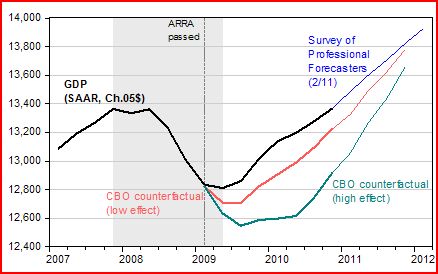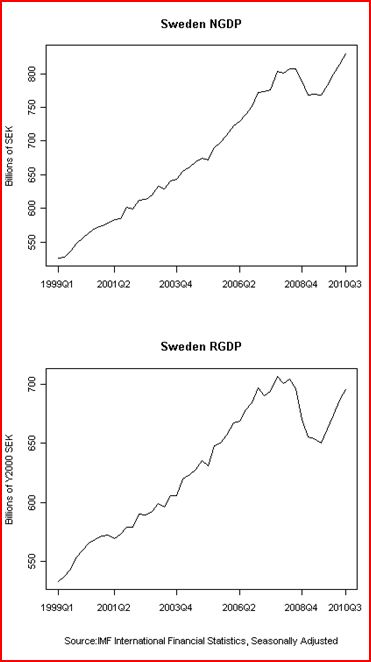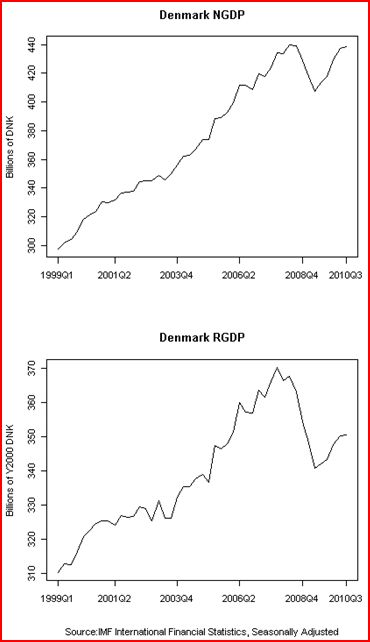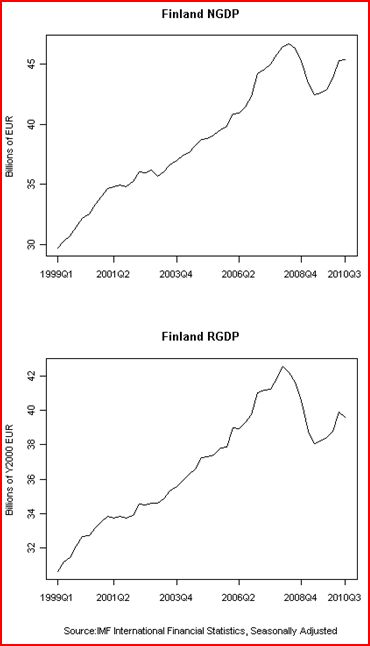Inflation targeting is a very bad idea
Mark Sadowski triggered an interesting discussion in a previous thread with the following comment about the UK:
The HICP was up 3.2% yoy in November. The core HICP was up 2.5% yoy in November. The HICP at constant tax rates was up 1.5% yoy in November. There is no “core HICP at constant tax rates”, but simple subtraction suggests that if there were one, it would be up by 0.8% yoy in November. Which means all the hysteria about inflation in the UK is a lot of nonsense.
Now I think we all agree price level targeting is superior to inflation targeting, and that NGDP level targeting is better still. But if you are going to target inflation rates than you should at least be targeting a measure of “inflation inertia”. The headline HICP in the UK is seriously skewed by the volatile energy and food component and the two VAT increases. Using the correct measure of inflation inertia, the real danger in the UK right now is deflation, not inflation.
All indications are that the Bank of England plans to tighten policy this May, with the idea of reducing aggregate demand growth in Britain. At a time of fiscal retrenchment, it is hard to overstate how misguided that policy is. And it will be justified by reference to the BOE’s mandate to engage in inflation targeting. If you think that is bad macro policy, then by implication you need to rethink the utility of inflation targeting. Here’s another way of stating how confused people are about stimulus. Suppose it is a good idea for the BOE to be raising rates in May. In that case, if it were true that fiscal retrenchment reduced the UK’s GDP in Q4, then that would be good news.
Mark’s comment points to one of the most serious problems with inflation targeting—there are all sorts of different inflation rates that people can point to. Headline inflation, inflation without food and energy, inflation holding interest rates fixed, holding the VAT fixed, etc. This creates a “gap” or grey area, where it is not clear whether the central bank should ease or tighten. In contrast, NGDP targeting is crystal clear. There is only one NGDP. If the UK were doing NGDP targeting, there would be no discussion of tightening in May, indeed they might ease by cutting rates a quarter point, or doing more QE.
Some liberals argue that this problem can be solved with fiscal stimulus. Not so. Fiscal stimulus works if and only if it raises AD, and by implication inflation (the SRAS is never completely flat.) If the central bank has the wrong inflation target, no amount of fiscal stimulus can boost AD. But additional fiscal stimulus can very much hurt AS. Indeed Britain has raised the top rate to 50% because of all the fiscal stimulus under the previous Labour government. This takes away Britain’s one big supply-side advantage over the continent, lower taxes on high-paid professionals in the City. Tight money and high taxes are a toxic combination. Just ask Herbert Hoover.
Two years ago I pleaded with Obama to talk to Christy Romer. I speculated that she favored monetary stimulus, and in another post I asked if Larry Summers was blocking access to the President. It was certainly bizarre to see Obama let 3 Fed seats lie empty for an extended period of time; he clearly didn’t understand the importance of monetary policy. In a new column in the New York Times, Christy Romer confirms my suspicions. She was aware of the need for monetary stimulus. She does understand that it can be effective at the zero bound. She does understand the importance of level targeting. If you put her and Larry Summers in a room together, most people would find Summers to be the far more impressive figure. I’d guess that President Obama did as well. Big mistake.
The commenter Ram provided the Romer link, and had this to say:
She has called for more monetary expansion before, but this is the clearest she has been about what she has in mind, not to mention how urgently monetary expansion is needed. It makes me wonder whether Prof. Sumner’s old post about Larry Summers being the Dick Cheney of the Obama administration might have some merit. Romer clearly supported and supports fiscal stimulus, but I seem to recall Larry Summers discussing the need for a large, government spending-oriented fiscal stimulus in mid-2008, before the bottom truly fell out of the economy. Maybe Romer was insisting on the importance of standing behind good monetary policy, so Summers deliberately kept her out of the inner circle. Hard to know, but it’s remarkable that she’d make this dramatic of a pivot so soon after leaving the White House.
There’s an easy way to tell unsophisticated old Keynesians from the more sophisticated new Keynesians. Do they call for fiscal stimulus when interest rates are positive. Even Krugman admits that there is really no case for fiscal stimulus until rates fall to zero. In September 2008 rates were at 2%, and the Fed refused to cut them after Lehman failed because they were worried about inflation. Indeed a month earlier some at the Fed wanted to raise rates (and I believe the ECB did raise rates.) In that environment fiscal stimulus does nothing.
But I don’t want to be too hard on the old Keynesians. When central banks around the world are this confused and incompetent, it’s not hard to see why people grasp for fiscal stimulus out of sheer frustration. Most people don’t have a clue as to how monetary stimulus works, or why it neutralizes fiscal stimulus (especially why it does so at zero rates.) Fiscal stimulus is really easy to grasp at an intuitive level. Throughout history, only a tiny number of economists have intuitively grasped the incredible power of monetary stimulus (even at zero rates) and also understood the need for monetary stimulus when NGDP is inadequate. Irving Fisher was one and Milton Friedman was another. Lots of people are aware of the power of monetary policy. Lots of people understand the need for stimulus. But damn few can see both. And that’s why we are where we are.
BTW: A long time ago I promised to post the video of Bentley’s team winning the Fed Challenge. It is finally available:
http://www.youtube.com/watch?v=pYl9AtIGAoQ&feature=feedu
Congratulations.






